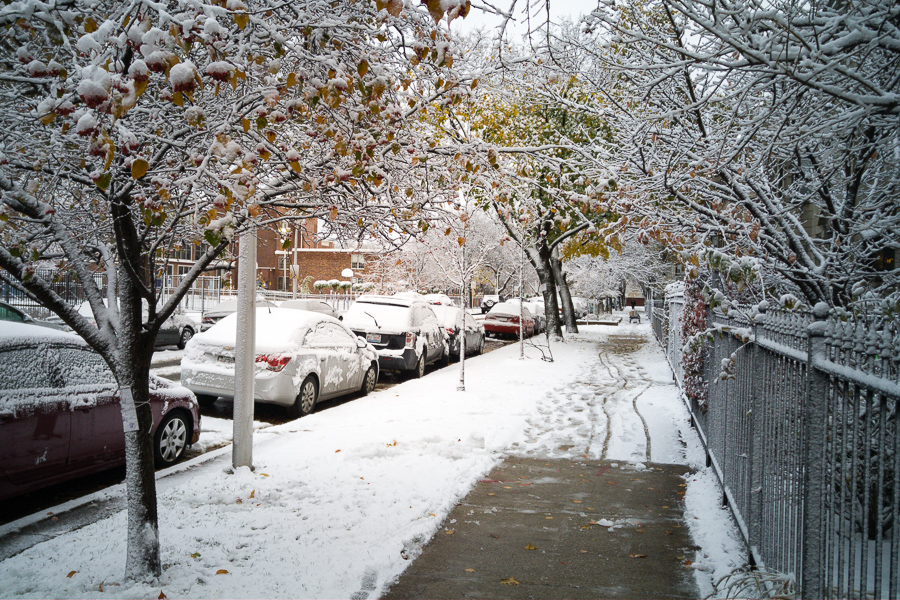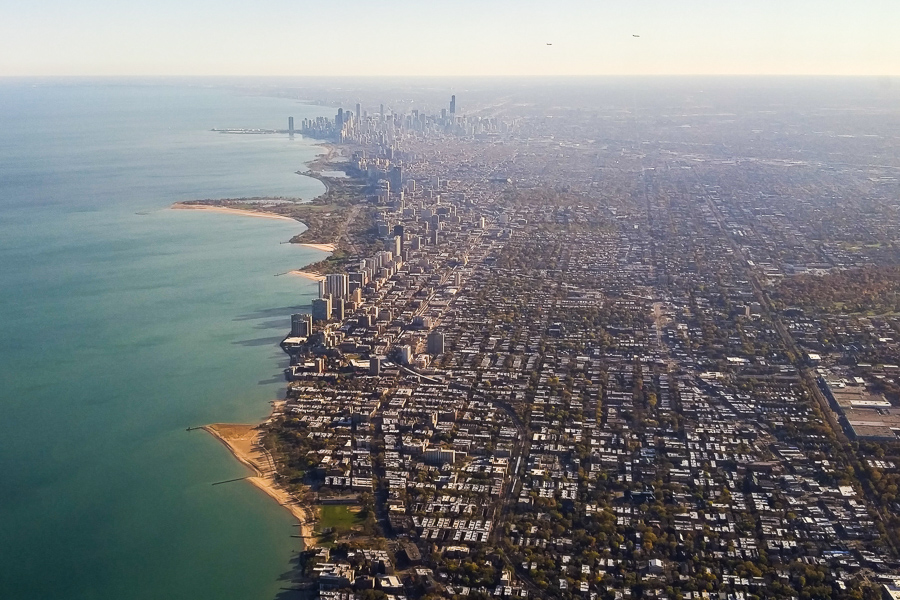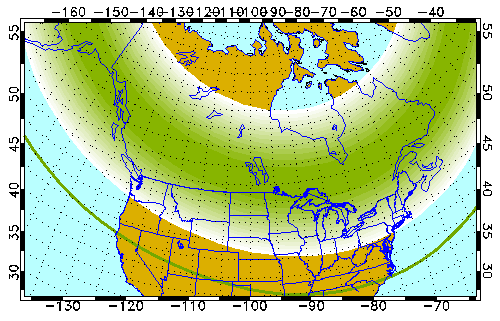For the last couple of days, I've missed my 10,000-step goal by 100 to 500 steps. This is why:

Yesterday Chicago got its biggest November snowfall in 120 years; today it's well below freezing. Walking is treacherous at best for bipeds and uncomfortable for quadrupeds. So today might also be a miss.
I haven't missed three days in a row since March 5th-7th—when, not coincidentally, we had a miserable, snowy week. Winter is hard on fitness.
The good: A new study shows that drinking 3-5 cups of coffee a day has measurable health benefits.
The bad: A black resident of Santa Monica, Calif., got hauled out of her apartment at gunpoint by 19 police officers after a white neighbor reported someone trying to break in.
The ugly: Yale law student Omar Aziz writes about the soul of a Jihadist.
And the neutral, which could be ugly: forecasters predict 15-30 cm of snow in Chicago tomorrow night into Saturday morning.
The L.A. Times reports today that temperatures in the Eastern Pacific are far higher than previous El Niño events:
Temperatures in this key area of the Pacific Ocean rose to 5.4 degrees Fahrenheit above average for the week of Nov. 11. That exceeds the highest comparable reading for the most powerful El Niño on record, when temperatures rose 5 degrees Fahrenheit above the average the week of Thanksgiving in 1997.
The 5.4 degree Fahrenheit recording above the average temperature is the highest such number since 1990 in this area of the Pacific Ocean, according to the National Weather Service.
But the center’s deputy director, Mike Halpert, cautioned against reading too much into the record-breaking weekly temperature data.
El Niño has so far been underperforming in other respects involving changes in the atmosphere important to the winter climate forecast for California, he said.
One example: tropical rainfall has not extended from the International Date Line and eastward, approaching South America, as it did by this time in 1997.
In Illinois, our temperatures in the first two weeks of November are also much higher as well. But:
In the last two big events, the above-average temperatures did not appear until December, January, and February. So what does it mean if this November is unlike 1982 and 1997? It just means that no two El Niño events behave in exactly the same way.
We don't know how winter will go; but so far, it feels a lot more like early October than mid-November.
I'm totally swamped today, so here are the things I haven't read yet:
Twenty minutes until my next meeting.
First, Pabu Izakaya, early Saturday night (pre-party):
The inscription reads, "One Time, One Place."
Second, yesterday, on approach to Chicago:

That's approximately over Devon Ave., on approach to 27R, as I predicted.
The normal high temperature in Chicago on November 2nd is 12°C, which we aleady hit between 7 and 8 am today. Yesterday Chicago got to 22°C at O'Hare and 23°C at Midway, with similar temperatures expected to continue through Thursday.
These temperatures make more sense mid-September than at the beginning of November. But we'll take them anyway. Temperatures will go back to normal Friday and Saturday, with frost expected Saturday night.
A G3-class solar storm (i.e., a big one) is predicted to hit the earth tonight, generating category 7 aurorae, which are rarely seen on earth:
Auroral activity will be high(++). Weather permitting, highly active auroral displays will be visible overhead from Inuvik, Yellowknife, Rankin and Igaluit, to Portland OR, Cheyenne, Lincoln, Springfield, and New York City, and visible low on the horizon as far south as Carson City, Oklahoma City, and Raleigh.
Here's the prediction map from the University of Alaska at Fairbanks:

But here's the observed aurora right now:

So, while the aurora isn't yet visible in Chicago, the solar storm might propel enough material into our ionosphere that we could see some auroral displays in a few hours—or tomorrow. The prediction for Tuesday calls for displays overhead central Wisconsin which would be visible down to St. Louis, weather permitting.
The only place in Chicago dark enough to see them is the lakefront. Parker and I might have to walk over there tomorrow evening.
Updates as events warrant...
Now that O'Hare's runway 10R/28L has opened, travelers on flights unlucky enough to land on the new tarmac have reason to be unhappy:
The normal taxi route from new runway 10 Right to the gate follows parts of three taxiways to wind around one runway instead of crossing over it, which would create potential collision risks.
But the taxi route then requires a turn to directly cross a different runway — staying behind planes that are taking off on that runway — followed by another turn, and then another runway to cross over, and a little more taxiing until reaching the core of the airport, where a left or right turn is required, depending on what concourse the plane is assigned.
When American Flight 1333 finally reached the fork in the taxiway requiring a left or right turn near the terminal core, a right turn onto taxiway Bravo would have taken the plane directly to its gate in Terminal 3 on the south end of the terminal buildings. But the Chicago Department of Aviation had closed a portion of Bravo because of Lima Lima construction, said FAA spokesman Tony Molinaro.
So the plane had to hang a left and taxi clockwise all the way around the terminals to reach Gate K5 at the south end of the terminal complex, Molinaro said.
City aviation spokesman Owen Kilmer said short-term pain will lead to "long-term benefits for passengers, including reduced taxi times and a more efficient process for aircraft landing at O'Hare.''
I'm still 2½ hours from landing...I just hope I'm not 3 hours from the gate. (Probably not, as flights from San Francisco tend to use the north corridors and land runway 9L/27R.)
If you live in the parts of the U.S. and Canada that observe Daylight Saving Time, don't forget to move your clocks back an hour tonight. It couldn't come soon enough, though this is the soonest it can come under the 2007 changes to DST observance.
This morning's 7:22 sunrise in Chicago is the latest we'll have to endure until next November 1st, but tonight's 5:47 sunset is the latest we'll get to have until March 6th. Tomorrow the sun rises at 6:23 and sets at 4:45, as our available daylight shrinks from 10 hours, 24 minutes today down to 9 hours, 7 minutes on December 21st.
I'm not a fan of the 2007 changes. I like switching to DST in the spring and switching back in the fall, but I also believe that mid-October (or even the end of September as they do in Europe) makes a lot more sense. At least mornings aren't so gloomy in the fall. (Not a lot we can do about the post-7am sunrises from December 2nd through February 5th, but we expect those two months to be gloomy.)
Of course, I'm not in Chicago at the moment, and it's plenty sunny here...